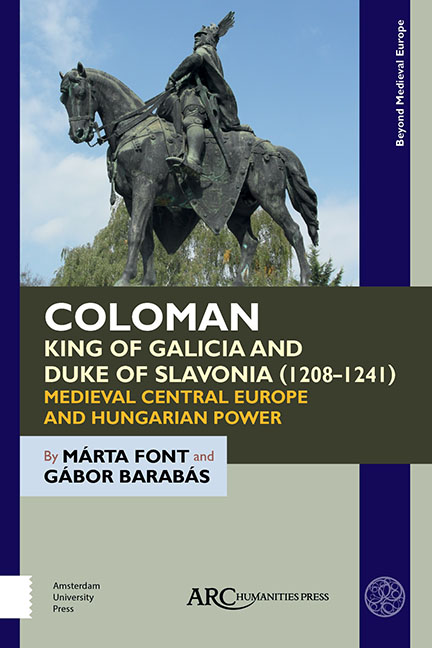 Coloman, King of Galicia and Duke of Slavonia (1208–1241)
Coloman, King of Galicia and Duke of Slavonia (1208–1241) Book contents
- Frontmatter
- Contents
- List of Illustrations
- Foreword
- Introduction
- PART ONE COLOMAN AS CHILD RULER OF GALICIA
- Chapter 1 The Galician Context in 1205
- Chapter 2 The Agreement of Scepus
- Chapter 3 Coloman’s Coronation as King of Galicia: Date and Place
- Chapter 4 The Hungarian Elite and Coloman’s Court
- Chapter 5 Coloman’s Position in Halych, 1215–22: Campaigns and Opponents
- Chapter 6 Upholding the Galician Claim: Coloman’s Place in Hungary
- PART TWO COLOMAN, DUKE OF WHOLE SLAVONIA (1226–1241)
- Chapter 7 Coloman and Scepus, Before 1226
- Chapter 8 Coloman as Duke of Whole Slavonia from 1226
- Chapter 9 Coloman’s Status and the Inner Workings of the Duchy
- Chapter 10 Coloman’s Ecclesiastical and Secular Actitivities in Slavonia
- Chapter 11 Coloman’s Rule in Slavonia
- Chapter 12 Politics and Dynastic Affairs
- Chapter 13 Challenges in the Balkans
- Chapter 14 The Mongol Attack and Coloman’s Death
- Conclusion: Coloman in the Eyes of Posterity
- Bibliography
- Index
Chapter 3 - Coloman’s Coronation as King of Galicia: Date and Place
Published online by Cambridge University Press: 20 November 2020
- Frontmatter
- Contents
- List of Illustrations
- Foreword
- Introduction
- PART ONE COLOMAN AS CHILD RULER OF GALICIA
- Chapter 1 The Galician Context in 1205
- Chapter 2 The Agreement of Scepus
- Chapter 3 Coloman’s Coronation as King of Galicia: Date and Place
- Chapter 4 The Hungarian Elite and Coloman’s Court
- Chapter 5 Coloman’s Position in Halych, 1215–22: Campaigns and Opponents
- Chapter 6 Upholding the Galician Claim: Coloman’s Place in Hungary
- PART TWO COLOMAN, DUKE OF WHOLE SLAVONIA (1226–1241)
- Chapter 7 Coloman and Scepus, Before 1226
- Chapter 8 Coloman as Duke of Whole Slavonia from 1226
- Chapter 9 Coloman’s Status and the Inner Workings of the Duchy
- Chapter 10 Coloman’s Ecclesiastical and Secular Actitivities in Slavonia
- Chapter 11 Coloman’s Rule in Slavonia
- Chapter 12 Politics and Dynastic Affairs
- Chapter 13 Challenges in the Balkans
- Chapter 14 The Mongol Attack and Coloman’s Death
- Conclusion: Coloman in the Eyes of Posterity
- Bibliography
- Index
Summary
THE DATE AND location of Coloman's coronation is nowhere mentioned in our sources. We know it happened and a few details are revealed thanks to four charters: two letters of Andrew II written to Pope Innocent III, a diploma of Honorius III, and a grant from the Hungarian sovereign to Demeter of the Aba kindred, one of the officials of the newly crowned Coloman. The last two sources were issued long after the events (in 1222 and 1234), and neither reveal the location nor the date, but do confirm the fact of the enthronement.
The first royal letter sent to Innocent III is dated to 1214 and must have followed the Scepus Council. Andrew II intended to handle several items. First, he requested papal permission for Coloman to be crowned king of Galicia by Archbishop John of Esztergom (filium nostrum […] in regem inungat). The second letter was meant to offer thanks for the received licence and formulated a petition for a golden crown for Coloman (coronam auream Regie dignitati congruentem filio nostri conferre). Furthermore, the Hungarian king promised to send a clergyman from Galicia to participate at the Fourth Lateran Council. The council started in November 1215, so the royal letter was probably written in August, at the very latest.
Regarding the coronation, while in the Kingdom of Hungary the reigning archbishop of Esztergom had the right to conduct the enthronement, this privilege concerned solely the Hungarian kings and it did not require papal permission. The case of Coloman was different; it was a new phenomenon with no precedent, and therefore papal licence was essential. Innocent III's approval was intended to be secured using the formulation of a request that it was motivated by the local elite and people, who were eager to join the Roman Church (Galiciae principes et populus, nostri ditioni subiecti humiliter a nobis postularunt). The Scepus Agreement was not even mentioned in the first letter, whereas the second mentions a matrimonial contract (contractum) and asks for papal mediation to convince Leszek to send help for Coloman, who was under siege in the castle of Halych.
- Type
- Chapter
- Information
- Coloman, King of Galicia and Duke of Slavonia (1208–1241)Medieval Central Europe and Hungarian Power, pp. 31 - 42Publisher: Amsterdam University PressPrint publication year: 2019


